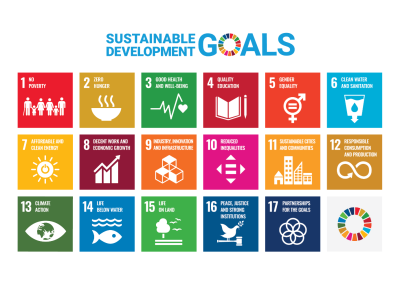1.8.4.2 From Limits to Growth to the Millennium Development Goals (MDGs) and to the Sustainable Development Goals (SDGs)
| [checked revision] | [checked revision] |
Caesajanth (talk | contribs) No edit summary |
Caesajanth (talk | contribs) No edit summary |
||
| Line 6: | Line 6: | ||
</loop_figure> | </loop_figure> | ||
The mining industry is particularly relevant to the SDGs. Here are some examples: [https://sdgs.un.org/goals/goal8 SDG 8 (Decent Work and Economic Growth)] is important as working conditions in a global set-up often do not follow the same standards of fairness in all areas of activity and as work safety issues are of particular concern for the sector. Further the industry “generates significant economic multipliers through local procurement and contributions to GDP, particularly in resource-dependent economies”<ref><small>ICMM - International Council of Mining and Metals (no date) <cite id="">IC25a</cite></small></ref> like many developing countries in the global South. [https://sdgs.un.org/goals/goal12 SDG 12 (Responsible Consumption and Production)] is key to mining as the goal points among others to the need for an enhanced waste management, including recycling and reuse, to minimize environmental harm. “Mining provides essential materials for modern life but also generates substantial waste. Increasing recycling rates and advancing a circular economy for metals requires collaboration across the entire value chain”.<ref><small>ICMM - International Council of Mining and Metals (no date) <cite id="">IC25b</cite></small></ref> [https://sdgs.un.org/goals/goal15 SDG 13 (Climate Action)] is a balancing act for the sector as on the one hand it contributes to creating a bigger carbon foot print as long as fossils like lignite continue to be extracted but as on the other hand the industry plays a key role in reducing greenhouse emissions by providing the raw materials it takes to foster renewables. Additionally, [https://sdgs.un.org/goals/goal15 SDG 15 (Life on Land)] | The mining industry is particularly relevant to the SDGs. Here are some examples: [https://sdgs.un.org/goals/goal8 SDG 8 (Decent Work and Economic Growth)] is important as working conditions in a global set-up often do not follow the same standards of fairness in all areas of activity and as work safety issues are of particular concern for the sector. Further the industry “generates significant economic multipliers through local procurement and contributions to GDP, particularly in resource-dependent economies”<ref><small>ICMM - International Council of Mining and Metals (no date) <cite id="">IC25a</cite></small></ref> like many developing countries in the global South. [https://sdgs.un.org/goals/goal12 SDG 12 (Responsible Consumption and Production)] is key to mining as the goal points among others to the need for an enhanced waste management, including recycling and reuse, to minimize environmental harm. “Mining provides essential materials for modern life but also generates substantial waste. Increasing recycling rates and advancing a circular economy for metals requires collaboration across the entire value chain”.<ref><small>ICMM - International Council of Mining and Metals (no date) <cite id="">IC25b</cite></small></ref> [https://sdgs.un.org/goals/goal15 SDG 13 (Climate Action)] is a balancing act for the sector as on the one hand it contributes to creating a bigger carbon foot print as long as fossils like lignite continue to be extracted but as on the other hand the industry plays a key role in reducing greenhouse emissions by providing the raw materials it takes to foster renewables. Additionally, [https://sdgs.un.org/goals/goal15 SDG 15 (Life on Land)] is a factor mining can have a significant impact on. While e.g. from open cast mining activities land degradation is a negative effect, rehabilitation of former mining sites can mean a major contribution to biodiversity . This is why it is important that every mining endeavour has a rehabilitation plan before mining activities commence. | ||
Revision as of 12:48, 17 August 2025
Developed in 2000, the MDGs set targets by 2015 concerning human development with a focus on developing countries. One of its eight targets was to “ensure environmental sustainability”.[1] However, the SDGs put even more emphasis on sustainability and climate issues and took a universal scope with altogether 17 goals, developed in a participatory process. Adopted by 193 – almost all – UN member states in 2015 as part of the UN 2030 Agenda for Sustainable Development, the SDGs show a broad consensus and hence are of great significance.

The mining industry is particularly relevant to the SDGs. Here are some examples: SDG 8 (Decent Work and Economic Growth) is important as working conditions in a global set-up often do not follow the same standards of fairness in all areas of activity and as work safety issues are of particular concern for the sector. Further the industry “generates significant economic multipliers through local procurement and contributions to GDP, particularly in resource-dependent economies”[2] like many developing countries in the global South. SDG 12 (Responsible Consumption and Production) is key to mining as the goal points among others to the need for an enhanced waste management, including recycling and reuse, to minimize environmental harm. “Mining provides essential materials for modern life but also generates substantial waste. Increasing recycling rates and advancing a circular economy for metals requires collaboration across the entire value chain”.[3] SDG 13 (Climate Action) is a balancing act for the sector as on the one hand it contributes to creating a bigger carbon foot print as long as fossils like lignite continue to be extracted but as on the other hand the industry plays a key role in reducing greenhouse emissions by providing the raw materials it takes to foster renewables. Additionally, SDG 15 (Life on Land) is a factor mining can have a significant impact on. While e.g. from open cast mining activities land degradation is a negative effect, rehabilitation of former mining sites can mean a major contribution to biodiversity . This is why it is important that every mining endeavour has a rehabilitation plan before mining activities commence.
Bernd G. Lottermoser /
Matthias Schmidt (Ed.)
with contributions of
Anna S. Hüncke, Nina Küpper and Sören E. Schuster
Publisher: UVG-Verlag
Year of first publication: 2024 (Work In Progress)
ISBN: 978-3-948709-26-6
Licence: Ethics in Mining Copyright © 2024 by Bernd G. Lottermoser/Matthias Schmidt is licensed under Attribution-ShareAlike 4.0 International Deed, except where otherwise noted.


Further Informationen:
Project "Ethics in Mining"